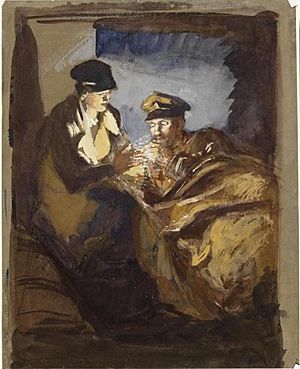Olive Mudie-Cooke facts for kids
Quick facts for kids
Olive Mudie-Cooke
|
|
|---|---|
| Born | 1890 London
|
| Died | 1925 (aged 34–35) France
|
| Nationality | British |
| Education |
|
| Known for | Painting |
Olive Mudie-Cooke (1890-1925) was a talented British artist. She is most famous for the paintings she created during World War I. Olive worked as an ambulance driver in both France and Italy during the war. Her experiences helping others greatly inspired her artwork.
Contents
Life as an Artist and Driver
Olive Mudie-Cooke was born in west London in 1890. She was the younger of two daughters. Her father, Henry Cooke, was a carpet merchant. Olive loved art and studied at two well-known schools: St John's Wood Art School and Goldsmiths College. She even worked in Venice, Italy, for a short time.
Helping During World War I
In January 1916, Olive and her older sister, Phyllis, went to France. They joined a group called the First Aid Nursing Yeomanry, or FANY. This group was made up of volunteers who helped during the war. Olive drove ambulances for FANY. Later, she also drove for a Voluntary Aid Detachment (VAD) unit.
While driving ambulances in France from 1916 to 1918, Olive started to draw and paint. She captured the scenes she saw around her. She painted her fellow ambulance drivers and the medical staff. Her artworks often showed wounded soldiers being moved. She also painted important parts of the evacuation process. For example, she drew ambulance trains waiting at stations. Besides the Western Front, Olive also drove ambulances in Italy during the war. She was very good at languages. She spoke French, Italian, and German. This skill allowed her to work as an interpreter for the Red Cross sometimes.
Her Art and the Imperial War Museum
After the war, in 1919, Olive's art caught the eye of the Imperial War Museum. This museum was new and wanted to collect art from the war. They bought several of Olive's paintings for their collection. One of these was her most famous picture. It is called In an Ambulance: a VAD lighting a cigarette for a patient.
In 1920, the British Red Cross asked Olive to go back to France. They wanted her to paint what the VAD units were still doing there. These units were still helping people and providing care. Her paintings from this trip showed war damage. They also showed the broken landscapes of old battlefields. She even painted women tending graves in a cemetery. Olive mostly used watercolours. Her paintings had a flowing style. However, she often used somewhat dark or muted colors.
Later Life and Legacy
After her work in France, Olive returned to Newlyn in Cornwall, England. She continued to work as an artist. In 1921, she had an exhibition of her art. It was held at the Cambridge University Architectural Society. From 1920 onwards, Olive traveled a lot. She visited many places in Europe and Africa. She went to South Africa, where she had another art exhibition in 1923.
Olive came back to England for a short time. Then, in 1925, she went to France. She passed away there in 1925. The next year, an exhibition of her work was held at the Beaux-Arts Gallery. Years later, her sister Phyllis gave more of Olive's artworks to the Imperial War Museum. This helped keep Olive's important wartime art remembered.


